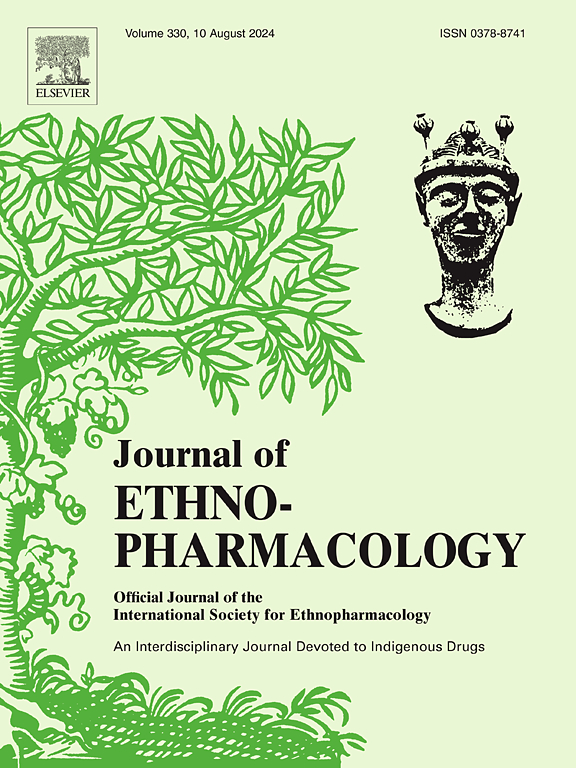Study on the effect of deer bone in improving rheumatoid arthritis based on the “drug-target-pathway” association network
IF 4.8
2区 医学
Q1 CHEMISTRY, MEDICINAL
引用次数: 0
Abstract
Ethnopharmacological relevance
Deer bone is rich in proteins, free amino acids, chondroitin, organic calcium, phosphorus ions, and other active components. Deer bone had been used widely in antiquity and were first compiled in renowned ancient masterpiece ‘Mingyi Bielu (名医别录)’ written by Hongjing Tao. The deer bone is recorded as non-toxic and has the effects of replenishing bones, strengthening sinews, expelling wind-dampness from the body, promoting muscle growth, and healing wounds. Modern pharmacological research suggests that deer bone can help promote bone density and enhance bone strength, making it potentially valuable for the prevention and treatment of diseases such as rheumatoid arthritis and osteoporosis. However, current studies on the component analysis and pharmacological effects of deer bone against rheumatoid arthritis (RA) are incomplete, which to some extent hinders the development and clinical application of deer bone drugs.
Aim of the study
The components of deer bone were elucidated by label-free proteomics, and the drug-target-pathway association network was established by network pharmacology. The in vitro validation of the pathway provides a theoretical basis for deer bone as a potential therapeutic drug for rheumatoid arthritis, and also lays a solid foundation for the subsequent clinical application of the in vitro experiments established through serum pharmacology.
Materials and methods
We performed extraction of deer bone using traditional water extraction methods and employed label-free proteomics technology to identify and conduct bioinformatics analysis on the proteins and peptides in the deer bone hot water extract (DBHE). These components were considered potential drug targets, and we constructed a “drug-target-pathway” association network. Analysis revealed that the HIF-1 signaling pathway may be pivotal in DBWE's effect on RA. Hypoxia influences the occurrence and development of ferroptosis through various mechanisms. Therefore, we hypothesized that DBWE might induce ferroptosis, promoting apoptosis in RA-FLS under hypoxic conditions, thereby alleviating RA. Therefore, we performed flow cytometry, ELISA, immunofluorescence, RT-qPCR, and western blotting based on molecular docking. Considering the overall effect of drug metabolism post-ingestion, we used serum pharmacology to prepare serum for cellular administration.
Results
It showed that DBWE reduces inflammation and synovial proliferation by inhibiting HO-1, increasing ROS production, upregulating ACSL4 expression and inducing RA-FLS apoptosis in hypoxic conditions. This study reveals the potential mechanism by which DBWE modulates ferroptosis to attenuate synovial proliferation in a hypoxic microenvironment and improve RA.
Conclusion
These findings not only provide a theoretical basis for deer bone as a potential therapeutic agent for RA, but also lay a solid foundation for subsequent clinical application through in vitro experiments established by serum pharmacology.

求助全文
约1分钟内获得全文
求助全文
来源期刊

Journal of ethnopharmacology
医学-全科医学与补充医学
CiteScore
10.30
自引率
5.60%
发文量
967
审稿时长
77 days
期刊介绍:
The Journal of Ethnopharmacology is dedicated to the exchange of information and understandings about people''s use of plants, fungi, animals, microorganisms and minerals and their biological and pharmacological effects based on the principles established through international conventions. Early people confronted with illness and disease, discovered a wealth of useful therapeutic agents in the plant and animal kingdoms. The empirical knowledge of these medicinal substances and their toxic potential was passed on by oral tradition and sometimes recorded in herbals and other texts on materia medica. Many valuable drugs of today (e.g., atropine, ephedrine, tubocurarine, digoxin, reserpine) came into use through the study of indigenous remedies. Chemists continue to use plant-derived drugs (e.g., morphine, taxol, physostigmine, quinidine, emetine) as prototypes in their attempts to develop more effective and less toxic medicinals.
 求助内容:
求助内容: 应助结果提醒方式:
应助结果提醒方式:


